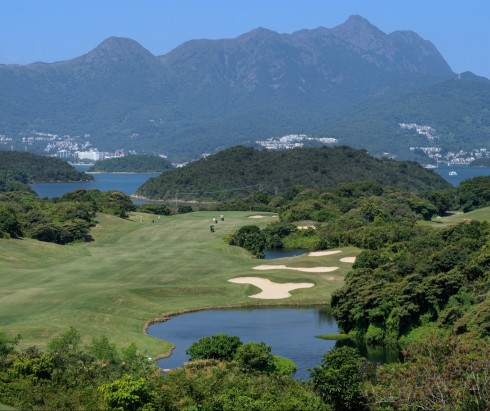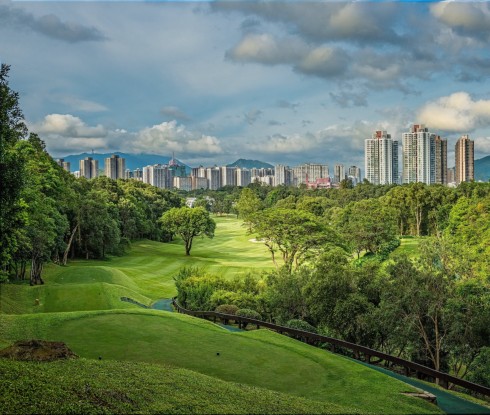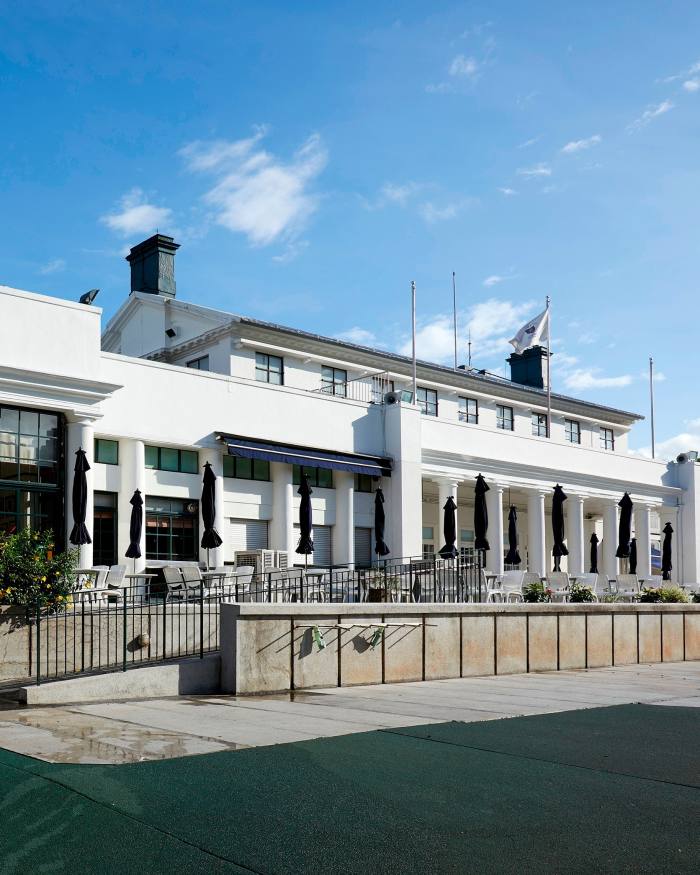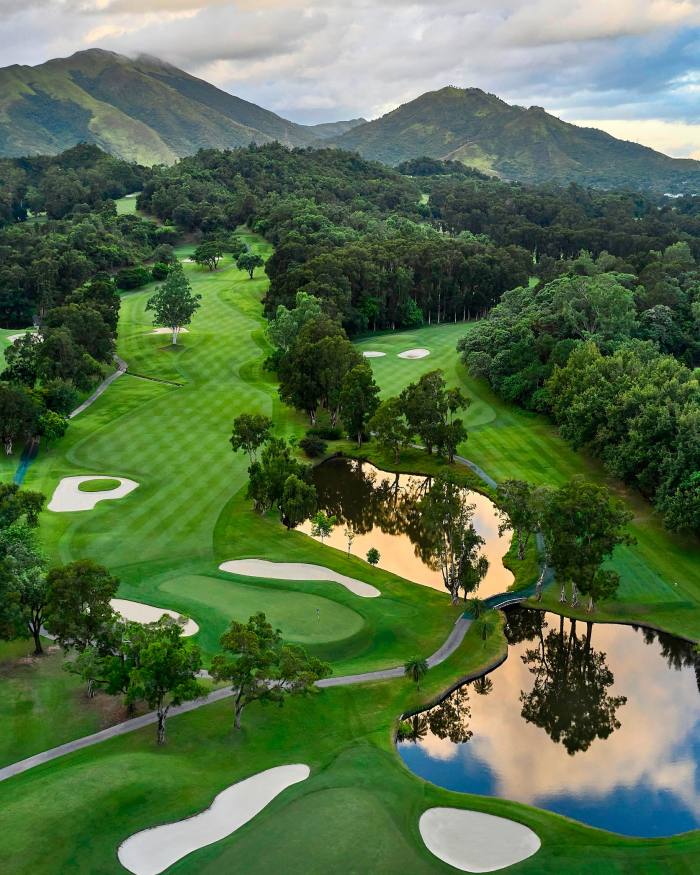If it ain’t got that swing: three of Hong Kong’s top golf courses
This article is part of a guide to Hong Kong from FT Globetrotter
To play golf regularly in Hong Kong requires deep pockets, impeccable social connections and luck. There are, after all, only eight clubs in the Chinese territory and not all accept visitors.
Alas for me, I took a taxi to the KSC ferry, so missed out on this vital advice before stepping on to the East course on the 670-hectare island.
KSC has three courses but booking a tee-off slot can be difficult. Theoretically, golfers can book up to seven days before a game, but even friends who get their PAs to phone the club repeatedly from 7am fail to secure a slot.
Last year KSC was forced to close for 104 days by Hong Kong’s strict Covid rules but still played host to 129,000 rounds. “We’ve been flat out since the travel restrictions [were imposed],” said Mike Carey, head of golf operations at KSC. Normally the peak golf season is between October and May, because in the summer it’s too hot and humid for golf. “But we’ve had peak golf season seven days a week for the last few years,” he added. Virtually every tee slot from 7am to 5.30pm on the three layouts is filled seven days a week.

Despite the enormous traffic, the holes are beautifully maintained and KSC must rank as one of the most impressive municipal golf courses in the world.
Foolishly, I was feeling fairly confident after a few decent rounds in Thailand the previous fortnight as I inserted my peg on the opening hole.
I trickled the ball off the tee but at least I could find it. That was to prove a highlight as I proceeded to lose at least one ball on almost every hole thereafter. Only the foolhardy or the pathologically mean would attempt to find a ball in the deep rough. Apparently the thick bush is alive with snakes, so when I skewed or pulled a drive into the trees, I simply reloaded.
I did record one triumph, though, on the breathtaking par-4 14th. From a tee high above the sparkling sea and with islands dotted all about, I landed my drive just the right side of the out-of-bounds marker.
My approach found the front bunker but somehow I managed to get up and down for a par.

In sharp contrast to my erratic round, my partners played beautifully. Shane Kuiti, the New Zealand senior pro, struck the ball so sweetly and with such effortless grace that, had he not being such a pleasant chap, I would have resented him.
For the past five years, Shane’s team has run an outreach programme for local schools, with thousands of children learning the game.
The club also hosts golf societies, which is one of the easier ways to secure a round. The WAGs, for instance, not only manage to ensure regular games for their members at quality courses, but raise money for charity, too.
I managed to insult only the East course with my erratic play, but friends tell me the North and South courses are excellent options, too. Both were designed by Gary Player, with the North said to have a “real links feel”. All three layouts, as well as the popular driving range, are served by the same clubhouse with wonderful views over the ocean, islands and the New Territories.
Hong Kong Golf Club
Visitors: Yes (Monday to Friday)
Official handicap required: Not for international visitors
Visitor green fees: HK$1,300 (about $165; £130) for locals; HK$1,900 (about $242; £191) for overseas visitors
Extra for golf-cart hire? HK$400 per cart (accommodates 2 players)
Caddies: HK$345–HK$505
Website; Directions
The Hong Kong Golf Club is the grand old lady of the Chinese territory and one of the oldest courses in Asia. Its nine-hole layout in Deep Water Bay is convenient for travellers staying on the island but, for a greater challenge, try get on to one of the three championship courses located in Fanling in the New Territories, just across the border from mainland China.

Some of the world’s best golfers, such as Tiger Woods and Rory McIlroy, have played here, and this year, after a pandemic hiatus, HKGC will host three international tournaments, including the Hong Kong Open in November.
The club also surrounds Fanling Lodge, the country house of the territory’s chief executive and before that the UK governor, who would host visiting royals at the estate. Many members of the city’s pro-Beijing government are allegedly members of the club, which must be rather awkward as the administration is demanding that nine hectares of the Old Course be given up for public housing.


The club is making a big effort to engage the local community through various initiatives and allows visitors Monday to Fridays. The take-up is phenomenal and in 2022, despite the 104-day enforced closure, 133,396 rounds were played across the three layouts.
The Old Course, which was built in 1911, is completely different to CWB and KSC in that it is a parkland course and relatively far from the coast. The layout is tree-lined and quite short, but the holes are cleverly designed and the greens small. Accuracy is a prerequisite. I am not an accurate golfer.
But I thoroughly enjoyed my round with Alex Jenkins, the club’s director of communication, who shared my disdain for fairways. The most interesting, verging on the ridiculous, hole is called Tommy Tucker. It’s a blind drive over a steep hill and then an approach to a tiny, flat green. I was thrilled to get away with a bogey.

Apart from three tremendous courses, HKGC also offers a driving range with TrackMan technology, restaurants, pool, sauna, futsal courts and both a billiard and mah-jong room.
As we sipped our Gunner, a classic and refreshing Hong Kong cocktail, on the terrace, reflecting on the tough conditions, Tiffany Chan walked off the course.
Chan is a local who played college golf in the US and represented Hong Kong in the Olympics before joining the LPGA tour. When asked how she played, she shrugged and said, “OK, I suppose.” She shot 67. Apparently the conditions weren’t that tough.
Tell us where you like to play golf in Hong Kong in the comments below. And follow FT Globetrotter on Instagram at @FTGlobetrotter
Cities with the FT

FT Globetrotter, our insider guides to some of the world’s greatest cities, offers expert advice on eating and drinking, exercise, art and culture — and much more
Find us in Hong Kong, Tokyo, New York, London, Paris, Rome, Frankfurt, Singapore, Miami, Toronto, Madrid, Melbourne, Copenhagen and Zürich
This story originally appeared on: Financial Times - Author:Fergus Ryan
























